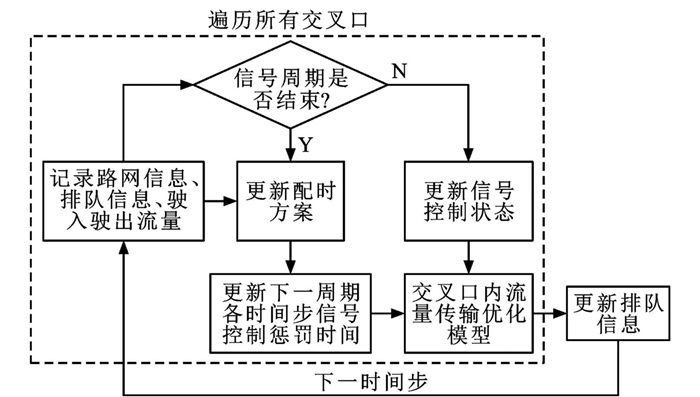-
摘要: 采用数值仿真方法评价了固定式信号控制、延误最小自适应信号控制与通行能力最大自适应控制3种典型信号控制策略下的路网动态运行效率; 采用双排队模型构建了动态交通流仿真平台, 提出了交叉口流量传输优化模型, 分析了双排队模型中交叉口内交通流运行的状态; 假定用户依据瞬时用户最优原则选择路径, 提出了考虑信号控制惩罚时间的瞬时用户最优约束; 以系统总行程时间、有无交通事件影响的行程时间为评价指标, 研究了低、中、高3级不同交通需求下的信号控制效果。试验结果表明: 在低、中级交通需求下延误最小自适应控制策略的系统总行程时间最小, 比通行能力最大自适应控制在无交通事件影响下总行程时间分别降低0.45%和0.18%, 在有交通事件影响下总行程时间分别降低5.95%和2.52%;在高级交通需求下, 通行能力最大自适应控制总行程时间最小, 对比延误最小自适应控制, 在有、无交通事件影响下系统总行程时间分别降低5.46%、5.31%;对比有无交通事件影响下系统总行程时间变化幅度, 固定式信号控制在不同交通需求下均表现出最高的稳定性; 在低、中级交通需求下, 延误最小自适应控制策略较通行能力最大自适应信号控制策略更稳定, 在高级交通需求下, 两者的稳定性无显著差异。可见, 当交通需求较大时, 应提升交叉口通行能力, 当交通需求较小时, 应降低车辆延误。Abstract: The numerical simulation approach was applied to evaluate the dynamic operation efficiency of road network under 3 typical traffic signal control strategies, including the fixed traffic signal control(FSC), the adaptive signal control minimizing vehicle delay(ASC-VD), and the adaptive signal control maximizing intersection capacity(ASC-IC). The dynamic traffic simulation platform was constructed by the double queue(DQ) model. An intersection traffic flow transfer optimization model was proposed, and the running state of traffic flow at the intersection in the DQ model was analysed. It was assumed that the users selected their routes according to the instantaneous user optimal(IUO) principle, and the IUO constraint was proposed considering the penalty term caused by the traffic signal control. The system total travel time and the travel time affected by traffic incidents or not were taken as evaluation indexes, the signal control effects under low, medium and high levels of traffic demands were studied. Analysis result shows that under the low and medium levels of traffic demand conditions, the system total travel time of ASC-VD is the lowest. Compared to the ASC-IC, the ASC-VD reduces the system total travel times by 0.45% and 0.18% without the influence of traffic incidents, respectively, and by 5.95% and 2.52% with the influence of traffic incidents, respectively. Under the high levels of traffic demand condition, the system total travel time of ASC-IC is the lowest. Compared to the ASC-IC, the ASC-VD reduces the system total travel time by 5.31% without the influence of traffic incidents, and by 5.46% with the influence of traffic incidents. Compared with the change range of system total travel time with or without the influence of traffic incidents, the FSC shows the highest stability under different traffic demands. Under the low and medium levels of traffic demand conditions, the ASC-VD performs more stable than the ASC-IC, while under the high level of traffic demand condition, the stabilities of the two strategies have no significant difference. Therefore, when the traffic demand is high, the intersection capacity should be improved, and when the traffic demand is low, the vehicle delay should be reduced.
-
Key words:
- traffic control /
- double queue model /
- traffic incident /
- traffic simulation /
- performance evaluation
-
表 1 信号控制惩罚时间
Table 1. Penalty times of signal control
路段 时间步 1 2 3 4 5 6 7 8 9 10 a 0 0 3 2 1 0 0 3 2 1 b 2 1 0 0 0 2 1 0 0 0 表 2 低级交通需求下OD矩阵
Table 2. OD matrix under low traffic demand condition veh·h-1
终点 起点 1 2 3 4 5 6 7 8 9 10 1 0 0 0 0 480 0 240 480 0 240 2 240 0 0 240 0 480 0 0 240 0 3 0 0 0 0 0 240 0 480 240 0 4 240 0 0 0 240 240 0 240 240 240 5 480 0 0 0 0 240 0 240 480 0 6 0 0 240 0 240 0 240 0 0 240 7 240 480 0 240 0 0 0 0 0 240 8 240 240 0 0 240 0 240 0 0 240 9 0 240 240 480 0 0 240 0 0 240 10 0 0 240 240 0 240 0 0 0 0 表 3 系统总行程时间
Table 3. System total travel times
控制策略 交通需求 有无交通事件影响 最小时间步 最大时间步 期望时间步 时间步标准差 t p FSC 低 无 1 658 437 1 672 055 1 665 567 2 710 2.649 0.008 有 1 658 870 1 673 400 1 666 180 2 944 中 无 2 353 151 2 367 275 2 360 012 3 117 2.131 0.034 有 2 353 818 2 367 323 2 360 545 3 016 高 无 8 091 426 8 170 419 8 132 731 17 929 2.378 0.018 有 8 097 779 8 173 129 8 135 958 15 199 ASC-VD 低 无 1 402 641 1 424 157 1 410 377 5 080 6.581 < 0.001 有 1 400 369 1 428 398 1 414 790 10 444 中 无 1 789 061 1 855 236 1 821 236 18 266 2.058 0.040 有 1 775 724 1 862 327 1 824 170 16 607 高 无 6 704 896 7 492 216 7 194 811 186 930 1.280 0.201 有 6 790 442 7 454 694 7 215 798 213 710 ASC-IC 低 无 1 403 790 1 436 459 1 416 767 11 460 7.683 < 0.001 有 1 412 230 1 432 350 1 423 212 8 933 中 无 1 776 424 1 894 483 1 824 600 47 911 8.281 < 0.001 有 1 791 109 2 001 795 1 870 259 82 607 高 无 6 552 413 7 150 553 6 813 046 227 472 0.570 0.569 有 6 580 594 7 093 754 6 822 835 191 534 表 4 有无交通事件条件下系统总行程时间t检验结果
Table 4. t-test results of system total travel times with and without traffic incidents
交通需求 无交通事件 有交通事件 t p t p 低 8.830 < 0.001 10.615 < 0.001 中 1.136 0.256 9.474 < 0.001 高 22.459 < 0.001 23.717 < 0.001 -
[1] KHATTAK A J, WANG Xin, ZHANG Hong-bing, et al. Primary and secondary incident management: predicting durations in real time[R]. Charlottesville: Virginia Center for Transportation Innovation and Research, 2011. [2] MARTIN P T, CHAUDHURI P, TASIC I, et al. Traffic incident management state of the art review[R]. Salt Lake City: University of Utah, 2011. [3] KOOREY G, MCMILLAN S, NICHOLSON A. Incident management and network performance[J]. Transportation Research Procedia, 2015, 6: 3-16. doi: 10.1016/j.trpro.2015.03.002 [4] HOJATI A H, FERREIRA L, WASHINGTON S, et al. Modelling total duration of traffic incidents including incident detection and recovery time[J]. Accident Analysis and Prevention, 2014, 71: 296-305. doi: 10.1016/j.aap.2014.06.006 [5] YU Hao, LIU Pan, MA Rui, et al. Performance evaluation of integrated strategy of vehicle route guidance and traffic signal control using traffic simulation[J]. IET Intelligent Transport Systems, 2018, 12(7): 696-702. doi: 10.1049/iet-its.2017.0283 [6] YAO Zhi-hong, ZHAO Bin, QIN Ling-qiao, et al. An efficient heterogeneous platoon dispersion model for real-time traffic signal control[J]. Physica A: Statistical Mechanics and its Applications, 2020, 539: 1-12. [7] DING Chuan, WU Xin-kai, YU Gui-zhen, et al. A gradient boosting logit model to investigate driver's stop-or-run behavior at signalized intersections using high-resolution traffic data[J]. Transportation Research Part C: Emerging Technologies, 2016, 72: 225-238. doi: 10.1016/j.trc.2016.09.016 [8] YU Hao, MA Rui, ZHANG Hong-jun. Optimal traffic signal control under dynamic user equilibrium and link constraints in a general network[J]. Transportation Research Part B: Methodological, 2018, 110: 302-325. doi: 10.1016/j.trb.2018.02.009 [9] CHEN Shu-kai, SUN Jian. An improved adaptive signal control method for isolated signalized intersection based on dynamic programming[J]. IEEE Intelligent Transportation Systems Magazine, 2016, 8(4): 4-14. doi: 10.1109/MITS.2016.2605318 [10] HUNTER M P, WU S K, KIM H K, et al. A probe-vehicle-based evaluation of adaptive traffic signal control[J]. IEEE Transactions on Intelligent Transportation Systems, 2012, 13(2): 704-713. doi: 10.1109/TITS.2011.2178404 [11] HU Jia, FONTAINE M D, PARK B B, et al. Field evaluations of an adaptive traffic signal—using private-sector probe data[J]. Journal of Transportation Engineering, 2016, 142(1): 04015033-1-9. doi: 10.1061/(ASCE)TE.1943-5436.0000806 [12] MAJID H, LU C, KARIM H. An integrated approach for dynamic traffic routing and ramp metering using sliding mode control[J]. Journal of Traffic and Transportation Engineering (English Edition), 2018, 5(2): 116-128. doi: 10.1016/j.jtte.2017.08.002 [13] ASLANI M, MESGARI M S, WIERING M. Adaptive traffic signal control with actor-critic methods in a real-world traffic network with different traffic disruption events[J]. Transportation Research Part C: Emerging Technologies, 2017, 85: 732-752. doi: 10.1016/j.trc.2017.09.020 [14] BALDI S, MICHAILIDIS I, NTAMPASI V, et al. A simulation-based traffic signal control for congested urban traffic networks[J]. Transportation Science, 2019, 53(1): 6-20. doi: 10.1287/trsc.2017.0754 [15] NIE Xiao-jian, ZHANG Hong-jun. A comparative study of some macroscopic link models used in dynamic traffic assignment[J]. Networks and Spatial Economics, 2005, 5: 89-115. doi: 10.1007/s11067-005-6663-6 [16] 李瑞敏. 过饱和交叉口交通信号控制研究现状与展望[J]. 交通运输工程学报, 2013, 13(6): 119-126. http://transport.chd.edu.cn/article/id/201306017LI Rui-min. Study status and prospect of traffic signal control for over-saturated intersection[J]. Journal of Traffic and Transportation Engineering, 2013, 13(6): 119-126. (in Chinese). http://transport.chd.edu.cn/article/id/201306017 [17] ROBERTSON D I, BRETHERTON R D. Optimizing networks of traffic signals in real time—the SCOOT method[J]. IEEE Transactions on Vehicular Technology, 1991, 40(1): 11-15. doi: 10.1109/25.69966 [18] LIU H X, OH J S, RECKER W. Adaptive signal control system with on-line performance measure for single intersection[R]. Berkerly: University of California, 2002. [19] REN Yi-long, WANG Yun-peng, YU Gui-zhen, et al. An adaptive signal control scheme to prevent intersection traffic blockage[J]. IEEE Transactions on Intelligent Transportation Systems, 2017, 18(6): 1519-1528. [20] SOH A C, RAHMAN R Z A, RHUNG L G, et al. Traffic signal control based on adaptive neural fuzzy inference system applied to intersection[C]//IEEE. 2nd International Conference on Open Systems. New York: IEEE, 2011: 237-242. [21] SMITH M, HUANG Wei, VITI F. Equilibrium in capacitated network models with queueing delays, queue-storage, blocking back and control[J]. Procedia—Social and Behavioral Science, 2013, 80: 860-879. doi: 10.1016/j.sbspro.2013.05.047 [22] SMITH M. A local traffic control policy which automatically maximizes the overall travel capacity of an urban road network[J]. Traffic Engineering and Control, 1980, 21: 11-31. [23] SMITH M. Traffic signal control and route choice: a new assignment and control model which designs signal timings[J]. Transportation Research Part C: Emerging Technologies, 2015, 58: 451-473. doi: 10.1016/j.trc.2015.02.002 [24] LAMMER S, HELBING D. Self-control of traffic signal lights and vehicle flows in urban road networks[J]. Journal of Statistical Mechanics: Theory and Experiment, 2008(8): 1-34. [25] MA Rui, BAN Xue-gang, PANG Jong-shi. Continuous-time dynamic system optimum for single destination traffic networks with queue spillbacks[J]. Transportation Research Part B: Methodological, 2014, 68: 98-122. doi: 10.1016/j.trb.2014.06.003 [26] MA Rui, BAN Xue-gang, PANG Jong-shi. A link-based differential complementarity system formulation for continuous-time dynamic user equilibria with queue spillbacks[J]. Transportation Science, 2018, 52(3): 564-592. doi: 10.1287/trsc.2017.0752 [27] RAN Bin, BOYCE D E, LEBLANC L J. A new class of instantaneous dynamic user-optimal traffic assignment models[J]. Operations Research, 1993, 41(1): 192-202. [28] 赵靖, 马万经, 韩印. 出口车道左转交叉口几何及信号组合优化模型[J]. 中国公路学报, 2017, 30(2): 120-127. https://www.cnki.com.cn/Article/CJFDTOTAL-ZGGL201702014.htmZHAO Jing, MA Wan-jing, HAN Yin. Integrated optimization model of layouts and signal timings of exit-lanes for left-turn intersections[J]. China Journal of Highway and Transport, 2017, 30(2): 120-127. (in Chinese). https://www.cnki.com.cn/Article/CJFDTOTAL-ZGGL201702014.htm [29] GAWRON C. An iterative algorithm to determine the dynamic user equilibrium in a traffic simulation model[J]. International Journal of Modern Physics C, 1998, 9(3): 393-407. [30] CETIN N, BURRI A, NAGEL K. A large-scale agent-based traffic micro simulation based on queue model[C]//STRC. Proceedings of 3rd Swiss Transport Research Conference. Ascona: STRC, 2003: 1-22. -





 下载:
下载:




